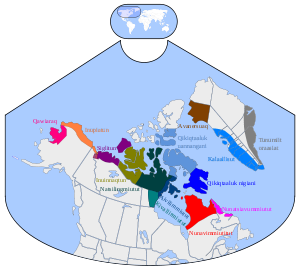- Inuktun language
-
Polar Inuit Inuktun Spoken in Qaanaaq area, Northern Greenland, Denmark Region North America Ethnicity Inughuit Native speakers approximately 1000 (date missing) Language family Eskimo–Aleut- Inuit
- Greenlandic
- Polar Inuit
- Greenlandic
Official status Regulated by No official regulation Language codes ISO 639-3 – Linguist List kal-pol  Inuit dialects. Inuktun is brown.
Inuit dialects. Inuktun is brown.This page contains IPA phonetic symbols in Unicode. Without proper rendering support, you may see question marks, boxes, or other symbols instead of Unicode characters. Inuktun (English: Polar Eskimo, Danish: nordgrønlandsk, polareskimoisk, thulesproget, Kalaallisut: avanersuarmiutut) is the language of approximately 1000 indigenous Inughuit, inhabiting the world's northernmost settlements in Qaanaaq and the surrounding villages in northwestern Greenland. All speakers of Inuktun also speak Standard West Greenlandic and many also speak Danish and a few also English. Apart from the town of Qaanaaq, Inuktun is also spoken in the villages of Muriuhaq, Hiurapaluk, Qikiqtat, Qikiqtarhuaq, Havighivik (names given in Inuktun). The language was first described by the explorers Knud Rasmussen and Peter Freuchen who travelled through northern Greenland in the early twentieth century and established a trading post at Dundas in 1910. Inuktun does not have its own orthography and is not taught in schools. However, most of the inhabitants of Qaanaaq and the surrounding villages use Inuktun in their everyday communication.
The language is an Eskimo–Aleut language and dialectologically it is in between the Greenlandic Kalaallisut and the Canadian Inuktitut. The Polar Inuit were the last to cross from Canada into Greenland and they may have arrived as late as in the eighteenth century.[1] The language differs from Kalaallisut by substituting Kalaallisut /s/ with an h-sound often pronounced like a palatal fricative as in German ich. Inuktun also allows more consonant combinations than Kalaallisut and has some minor grammatical and lexical differences.
Contents
Phonology
Vowels
Front Central Back Close i u Open a Consonants
Apart from the simple consonants given below, there are also 5 consonants which exist only in geminate (double) forms: <ss>, <ts>, <gh>[needs IPA], <rh>[needs IPA], and /ɴ/ (<rng>) (a uvular nasal).[check: verification needed]
Labial Alveolar Palatal Velar Uvular Glottal Plosive /p/ /t/ /k/ /q/ Fricative /v/ /ɣ/ /h/ Nasal /m/ /n/ /ŋ/ Approximant /l/ /j/ /ʁ/ Notes
- ^ Fortescue 1991. page 1
References
- Fortescue, Michael, 1991, Inuktun: An introduction to the language of Qaanaaq, Thule, Institut for Eskimologi 15, Københavns Universitet
External links
- Pax Leonard, Stephen. "Scientist lives with Arctic Innuguit for a year to document and help save disappearing language." The Guardian.
Eskimo-Aleut languages and dialects Italics indicate extinct languagesAleut Inuit* Greenlandic Tunumiit, InuktunInuinnaqtun Inuktitut Nunatsiavummiutut, InuttitutInupiaq Inuvialuktun Kangiryuarmiutun, Natsilik, Utkuhiksalik, SiglitunYupik Alutiiq Central Alaskan Naukan Sirenik** See also; Proto-Eskimo, Proto-Eskimo-Aleut, Inuktitut writing*The Inuit language 'family' is a continuum of dialects, but while people can understand the dialects closest to them, it becomes harder the further away they are.**Some linguists classify Sirenik as under a separate Eskimo branch, and not under Yupik.Categories:- Language articles with undated speaker data
- Languages with Linglist but no iso3 codes
- Agglutinative languages
- Inuit language
- Indigenous languages of the North American Arctic
- Languages of Greenland
- Languages of Denmark
- Endangered Eskimo-Aleut languages
- Inuktitut words and phrases
- Inuit
Wikimedia Foundation. 2010.
